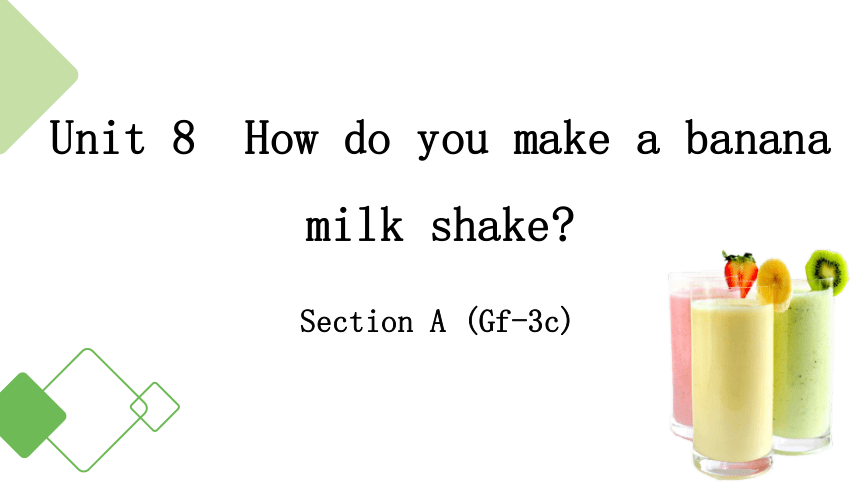(
课件网) Unit 8 How do you make a banana milk shake Section A (Gf-3c) To learn the imperatives, countable/uncountable nouns and adverbs of sequence . Learning target 01 Key words & phrases: sugar, cheese, popcorn, corn, machine, dig, hole, one cup of yogurt, how to plant a tree, dig a hole, how many, how much, take out ... from ... 02 Key sentences: 1. How do you make popcorn 2. How much corn do we need 3. What do we do next 03 Grammar focus 01 3a-3c 02 Contents Let’s chant Peel, peel, peel the banana. Cut, cut, cut up the banana. Pour, pour, pour the milk. Turn, turn, turn on the blender. Do you like fruit salad How do you make fruit salad You need these: watermelons apples yogurt oranges honey bananas First … Next … Then … Finally … 01 Grammar focus How do you make a banana milk shake First, peel the bananas. Next, put the bananas in the blender. Then, pour the milk into the blender. Finally, turn on the blender. Countable nouns Uncountable nouns How many bananas do we need We need three bananas. How much yogurt do we need We need one cup of yogurt. Grammar focus 祈使句表示请求、命令、警告、劝告、禁止等意思。 Language points 1 祈使句 1. 祈使句 的概念 2.祈使句 的类型 ①Do型 肯定:实义动词原形+其他 否定:Don’t+ 实义动词原形+其他 eg.Give me a book! ②Be型 肯定:Be+形容词 否定:Don’t+ Be+形容词eg.Don’t be shy. ③let型 肯定:Let+宾语+动词原形+其他 否定:Don’t + let + 宾语+ 动词原形+其他 eg.Let us go to school! ④No型 No+名词/动词-ing eg.No photos. ⑤其他型: 直接用名词、副词或用“名词+副词”等 eg.Help! 祈使句通常表示将要发生的动作,所以回答时一般用will或won’t。回答肯定形式的祈使句用will,回答否定形式的祈使句用won’t。 eg.— Don’t be late for school again. — Sorry, I won’t. 3.祈使句 的回答 1. 肯定形式的祈使句的反意疑问部分可用will you/won’t you /would you。 eg.Please keep quiet, will you 3. Let’s开头的用shall we,let us开头的用will you。 eg.Let’s go for a walk after supper, shall we 2. 否定形式的祈使句后只能跟will you。 eg.Don’t tell it to anyone else, will you 4. 祈使句 的反意疑问句 Language points 2 可数名词和不可数名词 1. 概念 可数名词是能够直接用数量进行计算的名词,有单复数之分。 不可数名词不能直接用数量进行计算的名词,没有复数形式。 可数名词前:可用a/an,具体数词以及many, few, a few, some, any, a lot of, lots of等 eg.many oranges 2.名词前的修饰词 不可数名词前:用much, little, a little, some, any, a lot of, lots of等以及表示量的短语(a cup/ glass of) eg.much milk 01 02 3.提问数量 可数名词提问数量用How many eg.How many apples do we need 不可数名词提问数量用How much eg.How much milk do we need 4.作主语 可数名词:单数形式作主语,谓语动词用单数形式;复数形式作主语,谓语动词用复数形式。 eg.These are bananas. 不可数名词:谓语动词用单数形式。不可数名词前有“基数词+量词+of”时,谓语动词依量词的数而定。 eg.Here is some rice. 一般情况直接加-s eg.map-maps 以s, x, ch, sh, 结尾的大多数名词,词尾加-es eg.bus-buses 以辅音字母加y结尾的名词,变y为i再加-es eg.family-families 以字母o结尾的名 ... ...

